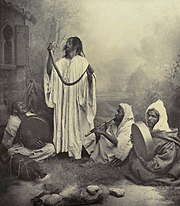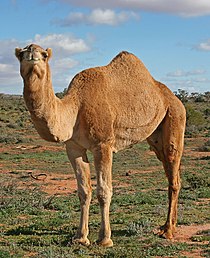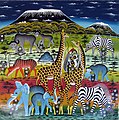Portal:Africa



Africa is the world's second-largest and second-most populous continent after Asia. At about 30.3 million km2 (11.7 million square miles) including adjacent islands, it covers 20% of Earth's land area and 6% of its total surface area. With nearly 1.4 billion people as of 2021, it accounts for about 18% of the world's human population. Africa's population is the youngest among all the continents; the median age in 2012 was 19.7, when the worldwide median age was 30.4. Based on 2024 projections, Africa's population will reach 3.8 billion people by 2099. Africa is the least wealthy inhabited continent per capita and second-least wealthy by total wealth, ahead of Oceania. Scholars have attributed this to different factors including geography, climate, corruption, colonialism, the Cold War, and neocolonialism. Despite this low concentration of wealth, recent economic expansion and a large and young population make Africa an important economic market in the broader global context. Africa has a large quantity of natural resources and food resources, including diamonds, sugar, salt, gold, iron, cobalt, uranium, copper, bauxite, silver, petroleum, natural gas, cocoa beans, and.
Africa straddles the equator and the prime meridian. It is the only continent to stretch from the northern temperate to the southern temperate zones. The majority of the continent and its countries are in the Northern Hemisphere, with a substantial portion and a number of countries in the Southern Hemisphere. Most of the continent lies in the tropics, except for a large part of Western Sahara, Algeria, Libya and Egypt, the northern tip of Mauritania, and the entire territories of Morocco and Tunisia, which in turn are located above the tropic of Cancer, in the northern temperate zone. In the other extreme of the continent, southern Namibia, southern Botswana, great parts of South Africa, the entire territories of Lesotho and Eswatini and the southern tips of Mozambique and Madagascar are located below the tropic of Capricorn, in the southern temperate zone.
Africa is highly biodiverse; it is the continent with the largest number of megafauna species, as it was least affected by the extinction of the Pleistocene megafauna. However, Africa is also heavily affected by a wide range of environmental issues, including desertification, deforestation, water scarcity, and pollution. These entrenched environmental concerns are expected to worsen as climate change impacts Africa. The UN Intergovernmental Panel on Climate Change has identified Africa as the continent most vulnerable to climate change.
The history of Africa is long, complex, and varied, and has often been under-appreciated by the global historical community. In African societies the oral word is revered, and they have generally recorded their history via oral tradition, which has led anthropologists to term them oral civilisations, contrasted with literate civilisations which pride the written word. During the colonial period, oral sources were deprecated by European historians, which gave them the impression Africa had no recorded history. African historiography became organized at the academic level in the mid-20th century, and saw a movement towards utilising oral sources in a multidisciplinary approach, culminating in the General History of Africa, edited by specialists from across the continent. (Full article...)
Selected article –
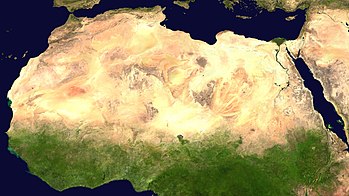
The African humid period (AHP; also known by other names) was a climate period in Africa during the late Pleistocene and Holocene geologic epochs, when northern Africa was wetter than today. The covering of much of the Sahara desert by grasses, trees and lakes was caused by changes in the Earth's axial tilt; changes in vegetation and dust in the Sahara which strengthened the African monsoon; and increased greenhouse gases. During the preceding Last Glacial Maximum, the Sahara contained extensive dune fields and was mostly uninhabited. It was much larger than today, and its lakes and rivers such as Lake Victoria and the White Nile were either dry or at low levels. The humid period began about 14,600–14,500 years ago at the end of Heinrich event 1, simultaneously to the Bølling–Allerød warming. Rivers and lakes such as Lake Chad formed or expanded, glaciers grew on Mount Kilimanjaro and the Sahara retreated. Two major dry fluctuations occurred; during the Younger Dryas and the short 8.2 kiloyear event. The African humid period ended 6,000–5,000 years ago during the Piora Oscillation cold period. While some evidence points to an end 5,500 years ago, in the Sahel, Arabia and East Africa, the end of the period appears to have taken place in several steps, such as the 4.2-kiloyear event.
The AHP led to a widespread settlement of the Sahara and the Arabian Deserts, and had a profound effect on African cultures, such as the birth of the Ancient Egyptian civilization. People in the Sahara lived as hunter-gatherers and domesticated cattle, goats and sheep. They left archaeological sites and artifacts such as one of the oldest ships in the world, and rock paintings such as those in the Cave of Swimmers and in the Acacus Mountains. Earlier humid periods in Africa were postulated after the discovery of these rock paintings in now-inhospitable parts of the Sahara. When the period ended, humans gradually abandoned the desert in favour of regions with more secure water supplies, such as the Nile Valley and Mesopotamia, where they gave rise to early complex societies. (Full article...)
Featured pictures –
Did you know (auto-generated) -

- ... that the Shady Rest Golf and Country Club was the home of John Shippen, the first African American to compete in the U.S. Open?
- ... that Godwin Obasi has been described as "Africa's gift to the world of climate science"?
- ... that actress Dorothy Van Engle starred in the 1935 movie Murder in Harlem with a "proto-feminist role" that was then a primary source of positive representation for African Americans in film?
- ... that the growth of Christianity in 20th-century Africa has been termed the "fourth great age of Christian expansion"?
- ... that goalkeeper Sophie Whitehouse, who has lived in England, Africa and the US, has been chosen to play soccer for the Republic of Ireland?
- ... that police in Indianola, Mississippi, shot an unarmed 11-year-old African-American boy after responding to his 9-1-1 call for help at his home?
Categories
Selected biography –
Rémy Mwamba (1921–1967) was a Congolese politician who twice served as Minister of Justice of the Democratic Republic of the Congo (then Republic of the Congo). He was also a leading figure of the Association Générale des Baluba du Katanga (BALUBAKAT).
Mwamba was born in 1921 in Vunga, Belgian Congo to a Luba family. After completing his education he took up work at the Élisabethville Parquet. He later co-founded and became secretary-general of BALUBAKAT. He served in the Collége Exécutive Général transitional government before being elected a senator of the newly independent Republic of the Congo in 1960. Mwamba was subsequently appointed to serve as Minister of Justice in the first government under Prime Minister Patrice Lumumba. On 5 September he and Lumumba were dismissed by the President. Following harassment by the new authorities, Mwamba fled to Stanleyville and joined a rival regime. Negotiations led to the creation of a new government in August 1961 under Cyrille Adoula and he resumed his work as Minister of Justice. Following his dismissal in July 1962, Mwamba joined the parliamentary opposition. He died in 1967. (Full article...)
Selected country –
 |
 |
||
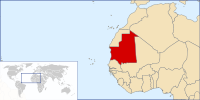
| |||
Mauritania (Arabic: موريتانيا Mūrītāniyā), officially the Islamic Republic of Mauritania, is a country in northwest Africa. It is bordered by the Atlantic Ocean on the west, by Senegal on the southwest, by Mali on the east and southeast, by Algeria on the northeast, and by the Moroccan-annexed territory of Western Sahara on the northwest. It is named after the ancient Berber kingdom of Mauretania. The capital and largest city is Nouakchott, located on the Atlantic coast.
Approximately three-fourths of Mauritania is desert or semidesert. As a result of extended, severe drought, the desert has been expanding since the mid-1960s. A majority of the population still depends on agriculture and livestock for a livelihood, even though most of the nomads and many subsistence farmers were forced into the cities by recurrent droughts in the 1970s and 1980s. Mauritania has extensive deposits of iron ore, which account for almost 50% of total exports. The nation's coastal waters are among the richest fishing areas in the world, but overexploitation by foreigners threatens this key source of revenue. (Read more...)
Selected city –

Suez (UK: /ˈsuːɪz/, US: /ˌsuːˈɛz/, Egyptian Arabic: السويس, romanized: as-Suways, pronounced [esseˈweːs]) is a seaport city with a population of about 800,000 as of August 2021[update] in north-eastern Egypt, located on the north coast of the Gulf of Suez on the Red Sea, near the southern terminus of the Suez Canal. It is the capital and largest city of the Suez Governorate. It has three ports: the Suez Port (Port Tewfik), al-Adabiya, and al-Zaytiya, and extensive port facilities. Together, the three cities form the Suez metropolitan area, located mostly in Africa with a small portion in Asia.
Railway lines and highways connect the city with Cairo, Port Said, and Ismailia. Suez has a petrochemical plant, and its oil refineries have pipelines carrying the finished product to Cairo. These are represented in the flag of the governorate: the blue background refers to the sea, the gear refers to Suez's status as an industrial governorate, and the flame refers to the petroleum firms of Suez. (Full article...)
In the news
- 15 February 2025 – Ituri conflict
- General Muhoozi Kainerugaba, Chief of Uganda's defence forces, claiming to act with the authority of his father, President Yoweri Museveni, threatens to invade the Democratic Republic of the Congo and take control of the city of Bunia, the capital of Ituri Province, unless "all forces" there surrendered their arms within 24 hours. Kainerugaba earlier claimed, without providing evidence, that people from the Bahima ethnic group were being killed. (Reuters)
- 14 February 2025 – Kivu conflict
- M23 campaign, Democratic Republic of the Congo–Rwanda conflict
- M23 rebels and Rwandan troops seize control of Kavumu Airport in South Kivu, Democratic Republic of the Congo. (DW)
- M23 forces and Rwandan troops enter the city of Bukavu, according to local security and humanitarian officials. There are no reports of resistance as most Congolese troops withdraw. (Digital Journal)
- Congolese president Félix Tshisekedi cancels his participation in an upcoming African Union summit to end the conflict due to the "situation on the ground". Tshisekedi accuses Rwanda of invading the country to seize its mineral-rich regions. (RFI)
- 13 February 2025 – Kivu conflict
- M23 rebels capture Kalehe Territory and Ihusi, Democratic Republic of the Congo, leading to several civilian casualties and the mass evacuation of residents. (BBC Gahuza)
Updated: 15:05, 15 February 2025
General images -
Africa topics
More did you know –
- ...that Iyabo Obasanjo-Bello, a Nigerian Senator from the People's Democratic Party, is the daughter of former President Olusegun Obasanjo?
- ...that the 2007 South Africa miners' strike, which impacted over 240,000 workers, was the first ever industry-wide miners' strike in the history of South Africa?
- ...that Seleh Leha, a town in Tigray Region in northern Ethiopia, was the site of a leprosarium built during the Italian occupation of East Africa and abandoned in 1941?
- ...that Sarir field, an oil field in Cyrenaica operated by the Arabian Gulf Oil Company (AGOCO), is considered to be the largest in Libya, with estimated oil reserves of 12 Gbbl (1.9×109 m3)?
Related portals
Major Religions in Africa
North Africa
West Africa
Central Africa
East Africa
Southern Africa
Associated Wikimedia
The following Wikimedia Foundation sister projects provide more on this subject:
-
Commons
Free media repository -
Wikibooks
Free textbooks and manuals -
Wikidata
Free knowledge base -
Wikinews
Free-content news -
Wikiquote
Collection of quotations -
Wikisource
Free-content library -
Wikispecies
Directory of species -
Wikiversity
Free learning tools -
Wikivoyage
Free travel guide -
Wiktionary
Dictionary and thesaurus














